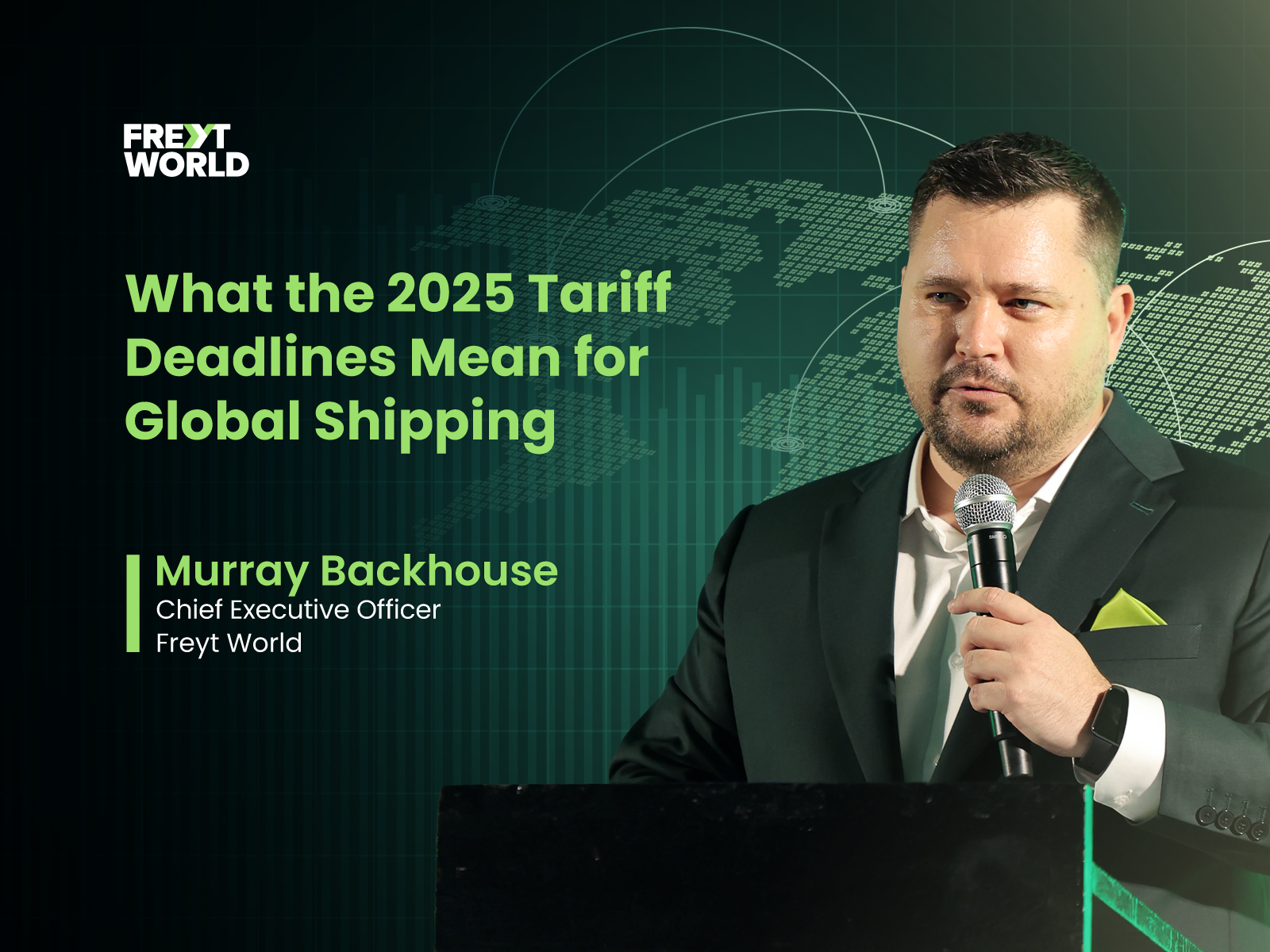By Murray Backhouse, CEO of Freyt Group for Freyt World

With July 9, 2025, marking the end of the 90-day pause on U.S. reciprocal tariffs for most trading partners—and August 12 looming as China’s deadline—the logistics industry faces a critical inflection point. The interplay of trade policy, supply chain dynamics, and economic data reveals a complex roadmap for the coming months. Here’s how these developments are likely to reshape global freight flows and what logistics leaders must prioritize to mitigate disruption.
The July 9 Threshold: A Pivot Point for Non-China Trade
The temporary tariff reprieve, enacted in May 2025, provided a respite for importers of goods from countries outside China, reducing rates from as high as 34% to 10%. However, this window closes on July 9, when tariffs on affected goods (e.g., steel, machinery, and consumer products) could revert to 11–50% unless extended. While negotiations continue, the likelihood of a broad agreement before the deadline remains low, given the U.S. administration’s focus on domestic production and trade deficit reduction.
Key Data Points:
- Frontloading Surge: Container bookings from non-China origins to the U.S. spiked by 22% in June compared to May, driven by importers accelerating orders to avoid higher costs post-July 9.
- Rate Volatility: Spot rates for transpacific routes from Southeast Asia to the U.S. West Coast have risen 18% since mid-May, reflecting tightened capacity and urgent demand.
For logistics operators, the immediate challenge lies in managing the congestion at U.S. ports, where container dwell times have increased by 30% since April due to tariff-related inventory surges . The risk of post-July 9 demand contraction—particularly in sectors like automotive and electronics—could exacerbate imbalances, leaving carriers with underutilized capacity on certain lanes.
China’s Three-Phase Adjustment: From Pause to Uncertainty
While July 9 dominates headlines, the larger strategic question revolves around China, which faces an August 12 deadline for its tariff truce. The interplay here is unfolding in three phases:
Phase 1: The Initial Surge (May–June 2025)
The May 12 tariff reduction from 125% to 10% triggered an immediate scramble to clear backlogged goods. Chinese exports to the U.S., which had plummeted 34.5% year-on-year in May , began recovering in June as manufacturers rushed orders delayed during April’s tariff spike. Containerized freight volumes from China to the U.S. jumped 50% in the two weeks following the pause, overwhelming port operations and driving spot rates up by $1,200/FEU.
However, this surge is largely a release of pent-up demand rather than new orders. As of late June, shipping analysts report that 60–70% of this “catch-up” cargo has already moved, suggesting capacity pressures will ease slightly in July.
Phase 2: The Frontloading Dilemma (July–Mid-August 2025)
The critical unknown is whether importers will accelerate orders ahead of August 12. May’s Caixin PMI (48.3) and official manufacturing PMI (49.5) signaled contraction, reflecting weak export orders and factory output. Yet, these surveys captured sentiment during the tariff standoff, not the post-pause rebound.
Early indicators suggest cautious optimism:
- Chinese export orders in June rebounded to 49.1 (from 47.2 in May), though still below expansionary thresholds.
- U.S. retailers have increased inventory orders for Q3 by 15% compared to 2024, signaling expectations of sustained consumer demand.
The logistics industry must prepare for a potential July surge as importers stockpile goods before August 12. However, the scale remains uncertain. If frontloading materializes, expect:
- Equipment Shortages: Containers and chassis in China may become scarce by late July, replicating early 2022’s supply chain crunch.
- Rate Inflation: Transpacific contract rates could exceed $4,000/FEU by August, up from $3,200 in June.
Phase 3: Post-August 12 Scenarios
If tariffs revert to 34% on August 12, container demand from China could drop by 25–30% within weeks, mirroring April’s collapse. Even a partial tariff reduction would likely cause a temporary dip as inventories normalize. For logistics providers, this volatility demands flexibility:
- Blank Sailings: Carriers may cancel 15–20% of scheduled Asia-U.S. voyages in Q3 to align capacity with demand.
- Modal Shifts: Air freight demand for high-value goods could rise 10–15% as importers seek to minimize tariff exposure on time-sensitive shipments.
Strategic Imperatives for Logistics Leaders
In this environment, success hinges on three actionable priorities:
- Dynamic Capacity Management
Leverage real-time data analytics to anticipate volume shifts. For example, Freyt World’s logistics platforms have reduced empty container repositioning costs by 12% by aligning asset availability with tariff-driven demand spikes.
- Diversified Sourcing Corridors
While Southeast Asia and India have absorbed 28% of diverted China-origin trade since 2024, these regions now face their own tariff risks post-July 9. Building redundancy across suppliers in Mexico, Eastern Europe, and Africa can mitigate concentration risks.
- Tariff Engineering
Collaborate with customs brokers to optimize product classifications and duty drawbacks. For instance, retooling procurement to qualify for Section 321 de minimis exemptions (for shipments under $800) has saved one retail client $4.2 million annually.
Agility as the New Currency
The tariff deadlines of July 9 and August 12 are not isolated events but markers in a prolonged era of trade policy volatility. For logistics professionals, the lesson is clear: Static supply chains are untenable. Companies that invest in predictive analytics, supplier diversification, and collaborative partnerships will outperform peers still clinging to pre-2025 operating models.
As the PMI data and freight rate curves remind us, uncertainty is the only certainty. The organizations that thrive will be those treating agility not as a buzzword but as a core competency—reshaping networks, reallocating resources, and redefining resilience in real time.

Freyt World Blog Contributor
Freyt World is a global logistics network uniting members from around the world. Our mission is to revolutionize global logistics through collaboration and innovation. Our platform goes beyond networking, enabling members to excel and grow together, featuring articles by logistics professionals for their peers. This series will cover industry-relevant issues and news, providing valuable insights for professionals in the field.


